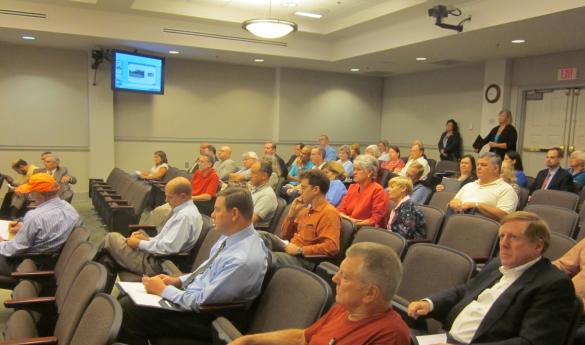Forum held to discuss university construction projects with community members
At a forum on Oct. 3, George Mason University officials spoke with community members to answer questions about ongoing projects and issues.
The forum was held a week after the Fairfax Campus Advisory Board meeting, where elected officials from the City of Fairfax and Fairfax County met with Mason to discuss collaboration across the campus perimeter.
President Angel Cabrera was in attendance at the forum to introduce himself to the community and to listen to the concerns they had with the university.
The audience received presentations on a new residential development being built along George Mason Boulevard, updates on Campus Drive road construction and other road improvements and renovations to the Field House and baseball field.
Eleven Oaks neighborhood
Eleven Oaks, an upscale residential development, will be constructed along either side of George Mason Boulevard. Currently, the City of Fairfax uses the east side of the road to house its public school buses, and to the west of the road, there is a vacant green space. A combination of town houses and single-family homes will be built, totaling 49 units.
At the forum, Douglas Stewart, representing of the Fairfax Coalition of Smarter Growth, expressed concerns over the expensive price of the homes, and the density of the development.
“The people that live in those townhouses don’t teach at Mason,” said Stewart. “Nobody at Mason could afford to live at these homes.”
Stewart added that low-density development creates dependency on automobiles.
“We’re just making our traffic problems worse,” said Stewart.
“Both of these rezoning’s have to be in accordance with the comprehensive plan,” said Baker, in reference to the county’s rules for how houses are built. Current plans recommend the density of the area to be seven units to the acre.
The town houses will sell for about $700,000 and the larger homes will be in the range of $750,000 and $900,000.
“This land has been in play for various projects for a long time,” said Tom Calhoun, Mason’s Vice President of Facilities, in an email. “The GMU Foundation attempted to buy the land but was unsuccessful. The cost of the land made it infeasible for lower cost student housing. Developers needed the townhouse revenue to offset the land cost.”
Apart from streetlights being added along George Mason Blvd., there will be no changes to the road itself.
During the initial planning for Eleven Oaks, Madison Homes, the developers, approached Mason and asked about the possibility of connecting the neighborhood’s storm water system with the existing one at the university.
“…[Madison Homes] can pay for and connect into the university's underground storm water management line which eventually leads to Mason Pond,” said Calhoun. “If it is determined that there is an increase in the pipe required Madison Homes will pay for that as well.”
If Madison Homes accepts the agreement, the storm water runoff in Eleven Oaks will help fill a new pond that will be installed in front of the new Health and Human Services Building, being built between University Hall and Rodgers dormitory.
“This idea of regional storm water management is not uncommon,” said Calhoun. “There are other places where drainage from ‘uphill’ transits through the university. But this is the only new development who's asked to use us for part of their storm water management.”
Madison Homes has yet to decide whether to connect to Mason’s system.
Field House Renovations
The Field House will undergo renovations, and prepare for increased traffic with the new West Campus connector road that will include more bus stops at the field house.
“This is really a two-part project: The image that it projects to the community, and the maintenance that is needed on the building,” said Cathy Wolfe the Mason Director of Campus Planning.
The roof will be replaced, and the word “Mason” will be printed in green on top, and a landscaped pedestrian path will be built between the Field House and the George Mason Stadium.
Apart from changes to the Field House, there will be additions to Spuhler baseball field, just west of the stadium. A tree buffer will be added around the stadium to reduce sound. There are currently no plans to install any additional lighting.
“There’s also a screen that will be added to the perimeter,” said Wolfe.
Both the Field House and baseball field renovations will begin mid-2013.
Digital sign relocation
At the forum, Wolfe brought up plans to add a digital sign to the entrance of the field house, displaying announcements about upcoming games and events.
“It would be nice to have a sign that could have a variable message on it,” said Wolfe.
“We’re in the early concepts . . . [the sign] is not funded in this particular project,” said Wolfe. “We’re going to look at feedback from the community.” Current plans for the Field House sign will put it at about six feet tall.
At the end of the meeting, several audience members expressed safety concerns about the existing digital sign along Braddock Road, just south of the Patriot Center.
State Delegate David Bulova (D-37) told the audience that there was a “process that the university should have gone through” to get the sign approved by the community.
“It’s something that I think you need to be cognoscente of,” said Bulova.
Anthony Velucci, former president of the Kings Park West Civic Association, which represents neighborhoods south of the university, asked Cabrera to explore plans to relocate it.
“If you want to be a good neighbor please find the money to move that sign to a commercial area,” said Velucci. “This is a residential area. It should be in a commercial area.”

